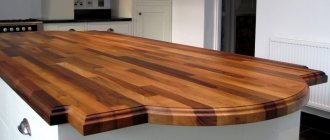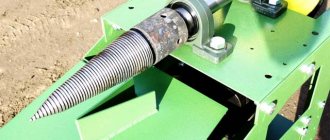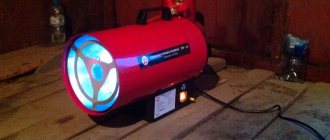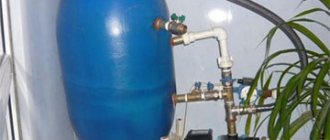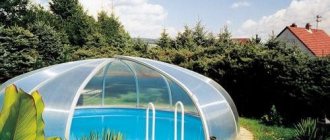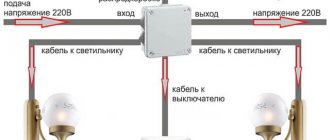Heat guns are auxiliary devices used to maintain a comfortable temperature during repair and construction work. But their application is more extensive: the devices are also used for household needs, and in everyday life they use a lot of structurally interesting homemade products.
We will tell you how to assemble a waste oil heat gun with your own hands. The article we have proposed presents the most popular schemes and provides recommendations for the competent implementation of developments. Tips for safe and trouble-free operation of manufactured units are provided.
Why is it profitable to buy a diesel gun: design advantages
Guns that heat rooms by burning diesel fuel have many undeniable advantages.
They are compact in size and light weight, while having excellent technical characteristics. These designs are easy to use. The mechanism is started with just one press of a button. The user has the ability to control the temperature in the room. Many diesel designs have a built-in system for connecting a rheostat. The operating principle of this mechanism is very simple. Before launching the gun, you just need to set the required parameter. When the room temperature reaches this value, the equipment will automatically turn off. If the temperature drops below the specified level, the structure will start on its own.
Diesel guns are economical; fuel consumption depends on the technical parameters of the device. Equipment with a power of 20 kW and a productivity of 550 m³/h will require about 1.5 liters of diesel fuel to heat this volume. Using such a gun, you can achieve quick results. According to the information stated by the manufacturers, diesel devices instantly warm up the room. The gun can raise the air temperature of +10°C in a room with a volume of 120 m³ to a level of +180°C in 15 minutes. Moreover, this speed is not the limit.
Small diesel fuel heat guns are convenient for use in closed, unheated rooms.
Diesel devices are safe to use. If the room is well ventilated, inhaling burnt-out air does not cause such unpleasant consequences as headaches and dizziness. High-quality designs are able to work for a long time without additional refueling. The guns are equipped with large-volume tanks, thanks to which they are able to operate continuously throughout the day.
On a note! The body of the structure is heated to a temperature of +30-35°C maximum. Therefore, accidental touching the gun will not cause burns.
Do-it-yourself gun being tested
The design of a heat gun is quite simple, so if you have certain operating skills, you can try to assemble such a unit yourself.
Homemade heater device
To make the device yourself, you can use a simplified diagram of a heat gun. At the bottom of the structure there is a fuel tank, above which there is a fan and a working chamber. The latter is supplied with fuel, while the fan pumps hot air into the room.
A self-made thermal device for testing will cost much less than one purchased in a store, but its technical characteristics are somewhat lower
In addition, the device contains a pump, a filter and a connecting tube through which fuel passes, a nozzle for the release of combustion products, a pipe for heated air and a number of other elements.
Required parts and materials
Before starting work, you should stock up on materials or ready-made components of the device.
When making a thermal heater using waste oil, you can use a sawn-off part of an old gas cylinder as a body.
The body of the heat gun, for which it is necessary to use thick-walled metal. For example, a suitable sized section of pipe or other suitable product can be used as this part. You can also make the body from a thick stainless steel sheet (3-4 mm) by welding the seam.
The combustion chamber. This part is suitable for a metal cylinder, the diameter of which is half that of the body.
Fuel tank. This element is a bowl made of a material with low thermal conductivity. An ordinary metal tank, carefully covered with a heat insulator, will also work.
The fan, which is necessary for the installation of a thermal device during mining, can be purchased at the store or use an existing device provided it is in good condition
Fan. To ensure a simple and reliable design, it is preferable to use a reliable and economical 220 volt impeller fan, which is easy to use and durable.
There are several articles on our website in which we examined in detail how to build a heat gun with your own hands. We recommend reading them too:
- Heat gun on different types of fuel.
- Waste oil heat gun.
- Diesel heat gun.
- Thermal gas gun.
Installation of the device during testing
First of all, you should take a pipe, cylinder or other outer shell of the device.
At the bottom there is a heater and a fuel tank, which must be separated from the top of the device at a distance of 15 cm. To make this part of the device look neater, it can be hidden in a metal box. A combustion chamber is installed in the center of the free space, for which a galvanized pipe can be used. The compartment is sealed on both sides, after which holes are made in it for the nozzle and smoke exhaust. The combustion chamber is firmly fixed to the walls of the housing. It is advisable to equip the working compartment with a piezo ignition, and also connect a fan to it. Next, you need to install a fuel pump with a nozzle, adding a filter between these parts
It is also important to organize an outlet pipe from the tank, through which the waste will flow to the fuel filter and injector. It is also necessary to resolve the issue of the fan's power source. If there is an electrical outlet within reach, this item can be plugged into an outlet
If it is not available, you will have to use a battery.
Finally, you need to cover the holes located at the top with nets.
Tips for using heat guns
Experts recommend paying attention to the following points when producing heating devices:
- When operating the device, you should follow safety rules: remember that at a distance of 1 meter from the device, the temperature of the heated air stream can reach 300 °C.
- To warm up a room of 600 square meters, only 10 liters of fuel are enough.
- It is necessary to clean the evaporation bowl, removing slag from the waste, once after 20-50 hours of operation of the device.
- Water should not be allowed to enter the fuel cell along with used oil or other types of fuel. If a large amount of this liquid gets into the tank, the burner may go out.
You should also not forget about fire safety rules: it is better not to leave homemade heating devices unattended, and also to have a fire extinguisher or other device for extinguishing a fire within reach.
How to weld a simple stove
Then the heat is released in greater quantities into the room, rather than being “thrown out” to the street. Another upgrade is to make an iron drawer. Oil is poured into it. With this design, the stove is easier to maintain. The drawing contains all the necessary dimensions. Before assembling a homemade oil stove, it is necessary to select the correct diameter of the firebox and body.
Here everything depends on the volume of the room that needs to be heated. If it is a garage of 3 by 6 meters, take a profile of 80x80x4 mm. The fuel box is made of metal 60x60x4. It is more difficult to work with round rolled metal.
The step-by-step instructions look like this:
- Cut the metal according to the drawings to make a casing, drawer, afterburner. If the latter has a bend, the tube is cut at an angle of 45 degrees.
- For a profile of a smaller standard size, one wall is cut out with a grinder. Plugs are welded to the sides. The result is an open container to which you need to attach a handle.
- The structure is welded. It is necessary to drill an air hole at the top of the fuel chamber. The pipe is perforated. At this point the work is completed.
It should be taken into account that you need to calculate the number and diameter of holes in the afterburner. If you use a profile of 80 by 80 mm, then the cross-sectional area will be equal to 6400 square millimeters. This value is divided in two
Pay attention to the markings of the drill used. If it is 8 mm, then the hole area will be 50 sq. mm. Now 3200 needs to be divided by 50
This results in a total of 64 holes required to operate effectively. However, as a result of customization, their number can be increased
Now 3200 must be divided by 50. The result is that 64 holes will be required to work effectively. However, as a result of customization, their number can be increased.
It is important that the chimney is of sufficient length. The elevation of the chimney outlet must be at least 5 meters. Then the operation of the stove during testing will ensure the highest possible efficiency even without supercharging
Otherwise, the pipe will have to be extended to this mark. But you can further increase productivity if you organize an inclined chimney running along the wall. The heated metal will release heat into the room. Only in this case is it important to follow fire safety rules. There should be no wooden shelves above the pipe, and no wallpaper on the walls. Even better is to cover the wall with a metal sheet.
Then the operation of the stove during testing will ensure the highest possible efficiency even without supercharging. Otherwise, the pipe will have to be extended to this mark. But you can further increase productivity if you organize an inclined chimney running along the wall. The heated metal will release heat into the room
Only in this case is it important to follow fire safety rules. There should be no wooden shelves above the pipe, and there should be no wallpaper on the walls
Even better is to cover the wall with a metal sheet.
Making a drip heater
Professionals who have assembled more than one “dripper” use old propane cylinders with a diameter of 200 mm. Oxygen ones are also suitable, since their cross section is 220 mm. the latter benefit due to thick walls. They serve for a long time, do not burn out, and accumulate heat. Pipe C-10 is also suitable if it has a wall thickness of 5 mm. An excellent option for a durable housing is pipes made of heat-resistant stainless steel alloys, alloyed chromium, molybdenum or nickel (for example, 15X1MF or 12X18H12T) with a wall no more than 3 mm. However, it is not advisable to specifically purchase this raw material due to its high cost.
Technologically, the manufacturing process is as follows:
- A flame bowl is made using a piece of pipe or ready-made steel containers. This one is pulled out through a rubber hatch, so it is not made too big.
- The openings necessary for connecting the chimney pipe and the cleaning service hatch are cut out in the body. The latter is framed and closed with a door. Bolts can be used for fastening.
- An afterburner is being made. All holes are not made at once. Usually the bottom 2-3 rows are drilled, and the rest are drilled during the setup process. If you do everything at once and there are too many of them, you will have to make a new one.
- Weld the cover with the air duct and flange. The latter is necessary for installing the fan. The fuel supply device is connected. Photo and video instructions will help here.
Now assemble all the components and connect the electrical wiring. The structure will be more stable if you make a metal frame. A heavy metal profile is suitable for this.
Principle of operation
Electric heat guns operate on the principle of convective heat exchange. By means of a fan, cold air moves to the heating element and is then supplied to the premises, while its temperature is already noticeably higher. Many modern models have a built-in thermostat that automatically turns off the heating if the required temperature indicators have already been reached, and then turns it on when the air in the room cools down. Typically, such a thermostat is located at a certain distance from the device itself, so it shows the actual temperature inside the room.
Required power parameter
The main indicator of a device is its power, because the effective functioning of the device depends on it.
To determine the required heat output of the device, it is important to simultaneously take into account a number of indicators:
- The volume of heated space, to calculate which it is enough to multiply its parameters (height, width, length).
- The difference between the temperatures outside and inside the room.
- An indicator of heat loss, the magnitude of which depends on the thermal insulation of the room. The average value of this indicator is 1-2, while an uninsulated building has an indicator of 3-4, and a well-insulated house has an indicator of 0.6.
A small value of the required power, indicated in kilocalories per hour, can be obtained by multiplying the above values.
In order to convert a specific figure into kilowatts, just multiply the quantity by 0.001163. This value must be taken into account when selecting a ready-made device in a store.
Other characteristics
We have analyzed the main parameters: the rest do not seem so important. But if you want to approach your choice with full responsibility, then study them too.
Air flow
Shows how much air mass the device creates per hour. This characterizes the heating speed and depends on the fan.
Bandwidth should be looked at in conjunction with power. If the flow rate is high and the heating capacity is low, the outlet stream will be barely warm. There is no sense in such equipment.
This option is not available for infrared models.
Dimensions
Compact samples have low productivity. Be prepared to deal with bulkiness if you require a high-power unit. In general, weight ranges from 1 to 1500 kg.
Electric guns weigh 3-70 kg, and gas guns from 3 to 700 kg. The range of mass of liquid fuel specimens is enormous: from a modest 1 kg to 1.5 tons.
Shape and material
The body can be in the shape of a pipe or a rectangle. The first one resembles a real military weapon with its elongated cylindrical shape. It is capable of producing higher temperatures than its competitor. At the same time, rectangular devices provide more uniform heat distribution due to the increased dispersion zone.
All structures are made of metal. This is due to the danger of melting the plastic. In household models there are plastic inserts, for example, handles and switches. As a rule, they are hidden in such a way as to prevent them from becoming overheated.
Functions
Heat guns do not differ in their variety of functions. These are already quite expensive products and there is no point in complicating them with additional bells and whistles.
Increased attention is paid to ensuring safety. The devices are equipped with a switch-off option when tipping over.
Liquid fuel and gas facilities are equipped with flame control: if it goes out, the fuel supply is stopped.
The thermostat helps control the heating level. As soon as the room temperature reaches the set value, the element stops working. Also, shutdown occurs if internal parts reach critical values. If you plan to leave the device unattended, then definitely buy a device with a thermostat.
Ventilation without heating allows you to mix the air in the room. And in hot weather, the device will replace your fan.
Several important rules that must be followed during installation work
During the installation of equipment that involves the use of liquid fuel, several general rules must be observed, as well as the requirements specified by the manufacturer of the equipment being installed.
Important rules include the following recommendations:
- diesel boilers cannot be installed in garages with a small area and city apartments, since the boiler itself takes up a lot of space, requires the placement of a fuel tank and has a high noise level;
- diesel equipment must be installed in separate rooms, the ceilings of which are at a height of at least two and a half meters
; - there must be a distance of more than one meter from the surface of the boiler to the opposite wall;
- the walls of the boiler room must be concrete or brick, covered with plaster or tiles;
- in the boiler room it is necessary to install doors of the third class of fire protection;
- no more than nine hundred liters of fuel should be stored in the fuel tank, which leads to the need to arrange a separate room for the tanks from the boiler room.
What guns do we repair?
They are used in cold weather; kerosene, gasoline, diesel fuel, and waste oil are used for refueling. The equipment is used in fuel and lubricants warehouses, oil depots, and automobile workshops. The machine's burner supports the combustion of engine oil, helping to utilize residual petroleum products and reduce fuel costs.
Direct heating devices
The efficiency of the equipment is 100%, since the fuel burns completely in them. The power of the guns is 220 kW, and they can operate for up to 15 hours. If there is a thermostat responsible for periodically disconnecting and turning on the unit depending on the ambient temperature in the room, the gun on one fuel tank can be constantly in operating mode for 24 hours.
It should be noted that the direct heating device consumes oxygen and emits exhaust gases along with the heated air. Therefore, there are restrictions on the use of such devices. They are used in rooms with a constant flow of oxygen. The machine must not be operated in places where people are present, as this will cause carbon monoxide poisoning.
Indirect heating devices
The design of the machines includes a gas outlet, thanks to which warm air enters the room. At the same time, there are no exhaust gases or other combustion products in the air. The operating time of the equipment is up to 16 hours.
The design has overheating protection, which turns off the unit when its surface reaches significant temperatures, and the option of controlling the burner flame. This function automatically turns off the device when there is no flame in the burner, thereby making it safe to use.
The equipment is suitable for use in rooms occupied by people. To maintain the combustion process, an influx of oxygen is necessary, that is, the heated space must be constantly ventilated.
Diesel devices
These devices operate only on diesel fuel and are used during winter construction. Diesel devices are designed with direct or indirect heating. They are less fuel efficient than multi-fuel models. But they are compact, mobile, powerful, thanks to which the space heats up faster and the temperature is maintained for a long time.
If you need repairs of diesel heat guns in St. Petersburg, call our managers. They will advise on issues of interest.
Gas models
The machines ensure complete combustion of the gas on which they operate. Their connection to the gas network makes the unit stationary. Gas appliances are used in agriculture and industrial buildings. It is better to entrust the repair of a gas heat gun to our specialists.
Gas guns can operate on bottled propane or butane. This makes them mobile and allows them to be moved from place to place.
Air heater using waste oil - Community "Garage Equipment and Tools" on DRIVE2
I’ve been heating my garage with waste oil for 8 years now, I’ve burned more than 5 tons during this time, I make changes to the stove every year, in the past I converted the stove to an air heater. The advantages of the air heater: it very quickly brings up a uniform temperature throughout the room, it’s become comfortable to work around the stove.
Previously it was like this: in the corner where the stove is located 30 degrees, in the opposite corner, distant from the stove 13, in the pit it is generally about 0 3 Now: air is taken from the pit in the lower part and fed into the stove (supercharging, VAZ 2108 engine with an impeller), this creates circulation. Oven made of pipe 275 mm, wall thickness 6 mm.
The stove is tightly welded into the housing where it is blown by a motor with an impeller (from a Toyota, from a radiator blower, purchased at a disassembly). The outlet air temperature is from 50 to 90 degrees, depending on the oil supply. Oil is supplied from a barrel, the oil pump motor of the Ural motorcycle drives the windshield wiper of the VAZ 2101.
note
The control is smooth, via PWM, the supply can be adjusted from 600 grams per hour to 2 liters (depending on needs. 1 liter of waste produces approximately 10 kW of heat).
You should also use PWM for blowing, when it’s warm outside and the stove is burning at minimum mode, you shouldn’t overcool it with high air pressure, oil combustion is highly dependent on temperature, if the stove is overcooled it will start to smoke and clog the chimney. There is a sump filter at the oil supply to get rid of from water. This stove is not afraid of water, but when water gets in with oil, micro-explosions occur and the stove begins to release smoke from the inspection hole, and even at the minimum mode, if water gets in, it can go out.
Control is fully automated: Power supply from a computer, for 12 volts, two PWMs for the oil pump and air blower, thermal relay, with the ability to set the desired temperature in the garage (automatically increases or decreases the oil supply, depending on the temperature)
And this is how it all began: the oven, oil supply by gravity, pressurization from the gate
But even then it warmed me up, I just had to keep an eye on it and constantly adjust the flow of oil: add cold, add heat, reduce heat. and the fluidity of the oil also depends on the temperature, so I had to run every half hour, especially in the morning when it flooded. They say correctly: laziness is the engine of progress.
Kindling directly in a white suit is possible: 100 grams of a special mixture from a bottle is poured through a funnel (70% diesel fuel and 30% gasoline, you can use the residue from washing parts) and a match is thrown through the inspection hatch. This is a red stove, the photo conveys unnatural colors.
Now it doesn’t get red hot, due to the airflow and cooling fins. Therefore, it does not burn out and less heat escapes into the chimney.
The air heater control panel is connected via a UPS from the computer. When the lights are turned off, the stove begins to go out smoothly, but without pressurization it smokes a little. With an uninterruptible power supply this problem is eliminated, and even during short-term outages the stove can be left on
Important
A drawing of the basics of stove construction and a description of the operating principle is here: yadi.sk/d/5nwWyOj0iybdV There are no advertisements or links, just a file, I hope this is not prohibited on this forum
Scope of application and principle of operation
The operating principle of such a unit can be compared to the operation of a fan, however, the heat gun releases warm air into the room rather than cold.
The air operating inside the housing is heated by heating elements or burners operating on various types of fuel.
The name “gun” is due to both the external resemblance of the device to an artillery gun and the powerful jet of heated air that the unit “shoots”
Heat guns of various modifications find a wide range of applications.
They are successfully used:
- in industry for heating large production and storage facilities;
- in agriculture to maintain comfortable air temperature in greenhouses, greenhouses, greenhouses;
- in construction for quick drying of plastered, painted or otherwise finished rooms;
- in everyday life for heating and drying utility rooms and garages;
- for heating residential buildings in emergency circumstances (for example, accidents on heating routes).
There are other ways to use such devices, for example, gas units are widely used when installing suspended ceilings.
Heat gun maintenance
Indirect heating diesel gun
All preventive maintenance work on equipment is limited to setting up and treating the air intake system, compressor and fuel pump. The procedure for each individual heat gun is approximately the same. Let's look at the details of maintenance using the example of a classic model with indirect heating and automatic flame control.
The design of a diesel heat gun cannot be called complex. The fuel is supplied to the injector by the pump, after which it is produced in the combustion chamber. The burner is ignited using a pair of electrodes. During operation, the fan drives the flow through the chamber. Indirect heating involves the presence of an independent circuit, as a result of which the combustion products have virtually no contact with the heated air.
Equipment prevention:
- Remove the casing and clean the fan from dirt.
- Disconnect the high-voltage wires from the combustion chamber and remove the fuel hose. Let's blow through the last one.
- Loosen the fasteners on the camera and remove the block. We remove soot.
- We unscrew the nuts at the end of the chamber and gain access to the nozzle. Let's blow it out.
- Let's put everything back together in reverse order.
What you need to know about the electric gun?
Unlike other types of heat guns, an electrical device can be made by almost any home craftsman familiar with the basics of electronics.
Although the efficiency of an electric gun is much lower than diesel or gas devices, it does not emit combustion products harmful to health and can be installed in any room - a residential building, a greenhouse, ancillary buildings.
The power of industrial guns varies from 2 to 45 kW, and the number of heating elements in them can reach up to 15 pieces
Let's look at how an electric unit works.
Design and principle of operation of the heat generator
Any electric gun consists of three main components: a housing, an electric motor with a fan and a heating element. The varieties of this type of device are described in detail in an article devoted to the classification and principles of operation of heat guns.
Additionally, the device can be equipped with any “bonuses” from the factory units - speed switch, heat regulator, room thermostat, housing heating sensor, engine protection and other elements, but they increase not only comfort and safety during operation, but also the cost of the homemade product.
The rate of heating of air throughout the entire volume of the room depends on the number and power of heating elements - the larger their area, the more active heat transfer will occur
An electric gun works like this:
- when connected to the network, the heating element converts electric current into thermal energy, due to which it heats itself;
- the electric motor drives the impeller blades;
- the fan forces air from the room inside the case;
- the cold air flow comes into contact with the surface of the heating element, heats up and, forced by the fan, is removed from the “barrel” of the gun.
If the appliance is equipped with a thermostatic element, it will stop the heater when the programmed temperature is reached. In primitive devices you will have to control the heating yourself.
Advantages and disadvantages of homemade guns
The main advantage of a thermal electric generator is the ability to use it in any room where there is a network of at least 220 W.
Such devices, even in a home-made version, are mobile, weigh little and are quite capable of heating an area of up to 50 m2 (theoretically, more is possible, but it is better not to experiment with high-power devices and buy a ready-made unit, and a gun from 5 kW will already require connection to a three-phase network) .
The performance characteristics of the device must correspond to the heated area. On average, for every 10 m2 you will need 1 kW, but much depends on the room itself - building materials, quality of glazing and the presence of insulation
Pros of a homemade electric gun:
- Saving money - factory units are not cheap, and you can assemble a heating device with a minimum of purchased parts or even completely from improvised means, removing the missing elements from old devices.
- Safety - of all homemade heat generators, the electric device is the easiest to operate, since it does not require a connection to gas or refueling with flammable fuel. With proper assembly of the electrical circuit, the risk of spontaneous combustion for such guns is minimal.
- Quick heating of the room - the work of a heat gun is much more effective than other options for homemade electric heaters, for example, fireplaces or oil radiators.
One of the disadvantages is the high energy consumption (the amount depends on the power of the engine and heating element). In addition, the operation of the fan is quite noisy, and the larger the wingspan and rotation speed, the stronger the noise produced will be.
Well, any drawback of a homemade electrical device is the likelihood of an error during assembly or connection, which can cause a short circuit in the network, electric shock and spontaneous combustion of the device.
What is a potbelly stove with a water circuit: the advantages and disadvantages of a popular stove
A potbelly stove is characterized by high heat transfer and fuel burning rate. These qualities are given to it by the materials from which the firebox is made (cast iron, steel, iron). The potbelly stove quickly flares up and heats up, and if a water circuit is connected to it, then the warm flue gases along the way also manage to heat the water for domestic needs.
When choosing the material from which it is best to make a potbelly stove, you need to be guided by the following indicators:
- Thermal conductivity is the property of metals, liquids and gases to conduct heat through themselves. The faster heat is transferred, the faster the object heats up or cools down. Foam plastic has low thermal conductivity - 0.036–0.050 W/m*C. Taking it in our hands, we will immediately feel that it is warm, because the foam does not transfer heat, but accumulates it. If you take a metal bar, you will feel the cold due to the high heat transfer.
- Heat capacity is the property of a material to accumulate heat. Water has the highest heat capacity, air is in second place, and cast iron, steel and iron are at the end of the list. Therefore, a metal stove heats up quickly and cools down just as quickly. In city houses, central heating radiators are filled with water, which gives off heat for a long time, heating the home.
List of materials used to create a potbelly stove:
- Steel.
- Cast iron.
- Iron.
- Brass.
- Aluminum.
- Copper.
| Material | Thermal conductivity, W/m*oС | Heat capacity, J/kg*oС | Melting point, oС |
| copper | 382–390 | 400 | 1085 |
| aluminum | 232–236 | 920 | 660 |
| brass | 97–117 | 400 | 900 |
| iron | 74 | 460 | 1539 |
| cast iron | 62,8 | 500 | 1200 |
| steel | 47 | 540 | 1500 |
| water | 0,6 | 4200 | — |
| building brick | 0,2–0,7 | 880 | 1000–1100 |
| Styrofoam | 0,036–0,050 | — | 150–200 |
| air | 0,025 | 1100 | — |
Copper is the most thermally conductive material of all those listed in the table. Its disadvantages are cost and melting point. Aluminum and brass have the same limitations. At high temperatures, a cast iron or steel stove will only turn red, but will do its job, while a copper, aluminum or brass stove will melt.
Potbelly stoves are most often made of steel because it has a high melting point and the highest heat capacity among all available materials
Making a stove from steel, iron and cast iron is justified due to the prevalence of these materials. From the point of view of thermal conductivity and heat capacity, they need fine-tuning. It is more expedient to use the thermal energy of the stove to heat water, otherwise it will simply go down the chimney
To limit heat loss, it is also very important to achieve complete combustion of the fuel.
The ideal way for a potbelly stove to work is when barely warm air comes out of the pipe, and all the energy is directed into hot water supply and heating the house.
Table: advantages and disadvantages of a potbelly stove
| Advantages | Flaws |
|
|
As can be seen from the table, a potbelly stove has a lot of disadvantages, so if you decide to install this design, you will have to take into account all its weaknesses.
Do-it-yourself wood-burning heat gun
- Fuel is loaded into the combustion chamber.
- As soon as the air heats up, the fan will turn on, which will be connected to the heating chamber pipe with a hood.
- There is a horizontal partition inside the cylinder; due to the fact that it absorbs the greatest thermal load, the air heats up quite quickly.
- The hot air coming from the second pipe can heat any point in the room.
The blowing device in this device is a fan, the choice of which depends on the area of the room: for a small room, a cooler located in a computer system unit is suitable. For medium-sized housing, you can use household fans located in hoods.
- Cut off the upper part of the cylinder; this must be done along the welding seam. For a more powerful design, it is necessary to trim the top below the weld seam. Before doing this, you need to unscrew the valve, and to prevent the remaining propane from exploding, fill it with water. If this is not done, then working with an angle grinder will be dangerous.
- Make additional parts. Cut a circle of about 300 mm in size from metal; it will act as a partition. For the doors you need to frame them in the form of a strip 80 mm wide. If the material remains, then small strips can be cut from it, which will be used for heat exchange fins.
- Make a grate, adjusting the length of its rods to the size of the cylinder, then place it in its lower part.
- Cut openings to accommodate loading door. The door frame is inserted into them; they are a welded structure made of strips. You should first prepare the doors by welding hinges and handles to them.
- Make an air chamber. Place the prepared metal circle instead of the cut off upper part and weld it tightly. Attach a fan in it and weld the fins.
- Install the chimney pipe.
General operating principle
If we want to get high-quality heating based on waste, we cannot simply take the oil and set it on fire, as it will smoke and stink. To avoid these unpleasant and hazardous side effects, you need to heat the fuel so that it begins to evaporate.
Volatile substances obtained as a result of heating will burn. This is the basic principle of operation of the heating unit during testing.
Application of perforated tube
To implement this principle, the design of the stove includes two chambers, which are connected to each other by a pipe with holes. Fuel enters the lower chamber through the filler hole, which is heated here. The resulting volatile substances rise up the pipe, becoming saturated with air oxygen through the perforation.
The resulting combustible mixture ignites in the chimney, and its complete combustion occurs in the upper afterburning chamber, separated from the chimney by a special partition. If the process technology is properly followed, virtually no soot or smoke is generated during combustion. But the heat will be enough to warm the room.
Using the plasma bowl
In order to achieve maximum efficiency of the process, you can go a more complicated route. Let us recall that our goal is to separate volatile components from the fuel by heating it. To do this, a metal bowl should be placed in the only chamber of the unit, which must not only be heated, but heated.
Installation and connection of a heat gun
The method of connecting the heater depends on the type of its drive. There are also general operating rules that must be followed when connecting any heat gun.
General rules for operating a heat gun:
Place the device only on a flat surface. It is advisable to leave a gap of at least one and a half meters from the ceiling to the cannon. Do not lean the back of the heater against walls or other objects. Do not cover the heat gun nozzle. This reduces its effectiveness and increases the risk of overheating and even fire. It is advisable that there be at least three meters of empty space in front of the outlet. Do not attach any sleeves to the gun nozzle. Do not place any objects on the heat gun. Do not move the heat gun while it is on. Do not point the heat gun at flammable objects. Do not use a heat gun in places where there are vapors of flammable or explosive substances: gasoline, acetone, alcohol, etc. Do not turn on the heat gun in places where there is a lot of dust. Do not use the heater in areas with high humidity or outdoors during rain. Do not leave the heat gun running unattended. Do not make any changes to the design of the heat gun. During repairs, use only the parts specified in the instructions. If you want to disassemble, refuel or repair the heater, you need to turn it off and unplug it. If you use the heater indoors, do not forget to ventilate it at least occasionally. If the heat gun is dirty and dusty, then it needs to be cleaned before turning it on. Before using the device at full power, allow it to warm up for an hour or two
This is especially important in winter when working outside or in cold rooms.
Step-by-step instruction
The first step is to make the body. You can use sheet steel 3-4 mm thick or a regular pipe. The sheet needs to be given the required parameters, and then it needs to be rolled into a pipe. The edges are secured with bolts or a special connecting lock.
After this, the pipe that is used to supply gas is sawn. This is necessary so that later it will be possible to weld the next element to it.
Homemade gas gun:
Now it is necessary to increase the diameter of the hole, which is intended for gas to enter the system. You need to bring it to 5 mm.
Then the heat exchanger is manufactured. Take a metal pipe with a diameter of 80 mm. The end must be welded to the burner wall and a hole must be drilled. The burner extension passes through this element.
To allow the heated air to escape, a hole must be made in the heat exchanger housing. Then weld a tube with a diameter of 8 cm in that place.
Finally, you need to drill holes to ignite the gas. It is also necessary to provide a structure on which the heat gun will be located. You can use a ready-made stand or weld it from reinforcement.
Heat gun. with your own hands:
Where can I get oil?
The main suppliers of used oil are:
- all types of vehicles, including agricultural and special ones;
- railway transport;
- sea and river transport;
- aviation;
- all types of hydraulic equipment, including various machines.
Therefore, to purchase used oil, contact those organizations or entrepreneurs that service these types of equipment or keep them on their books.
After all, equipment requires periodic maintenance, and used lubricating or hydraulic fluid must be disposed of somewhere, but storage and disposal are legally very expensive .
Therefore, there is a high probability that they will sell or give you a fairly large volume of such a product for free, and perhaps they will even deliver it to the storage location themselves.
Types of gas guns
Air can be heated in one of two ways:
- direct heating;
- indirect.
Gas guns (either your own or factory-made) with direct heating have a fairly simple design, which is why their cost is low. In them, the burner is not insulated in any way, so that, in addition to heated air, gas combustion products also enter the room. For this reason, the device is compact and demonstrates good efficiency. But if you use it to heat a living space, you must first ensure that it (the room) has a good ventilation system that removes combustion products.
Video
Guns operating on an indirect principle are equipped with insulated combustion chambers. They have special pipes through which these products are removed and which are connected to the common chimney. They are ideal for any type of premises where many people gather.
All this is a description of stationary guns, but besides them, there are also portable or mobile guns. They are used in conjunction with gas cylinders. To make it convenient to transport and operate the device, it has special wheels and handles.
Note! Mobile guns require strict adherence to safety rules. The operating time of such devices is dictated only by the volume of the gas cylinder; fuel consumption ranges from 0.6-7 liters. at one o'clock
In order to extend the battery life, there are special adapters that allow you to connect the device to several cylinders at once. The most economical option is a gun that is equipped with a thermostat. With it, the device turns off after the required room temperature is reached. In short, heating the room with such guns is an opportunity to save on heating
at one o'clock. In order to extend the battery life, there are special adapters that allow you to connect the device to several cylinders at once. The most economical option is a gun that is equipped with a thermostat. With it, the device turns off after the required room temperature is reached. In short, heating the room with such guns is an opportunity to save on heating
The operating time of such devices is dictated only by the volume of the gas cylinder; fuel consumption ranges from 0.6-7 liters. at one o'clock. In order to extend the battery life, there are special adapters that allow you to connect the device to several cylinders at once. The most economical option is a gun that is equipped with a thermostat. With it, the device turns off after the required room temperature is reached. In a word, heating the room with such guns is an opportunity to save on heating.
Briefly about the main thing
An electric probe, a heated drain plug, a heating element and a heating plate - with these simple means you can safely heat the oil inside the engine in winter before starting. In fact, you don’t need to invent anything - each of the four options is available for purchase on many trading platforms.
In terms of power supply, there are no difficulties: a wire and a plug or a simple electrical circuit based on a relay and a toggle switch. Another question is whether it is necessary. The answer is short and advisory in nature: it is necessary, especially in cold weather worse than -10°C.
Many motorists are forced to think about how to heat the engine sump with their own hands due to the weather conditions in winter, which affect the normal starting of the engine. Some drivers mistakenly believe that in winter it is difficult to start the power unit due to weak battery power. In fact, the problem is caused by a change in the lubricant, which becomes very viscous, making it difficult to start the engine and the functionality of the crankshaft.
Ineffective lubrication in the initial minutes of engine start leads to excessive wear of the piston unit. These troubles can be avoided by heating the crankcase and eliminating excessive oil viscosity.
Diesel options
Malfunctions of a diesel heat gun include the following important points:
- Fuel is supplied to the combustion chamber intermittently. The appearance of this defect is primarily associated with contamination of the fuel tank and its supply system. In this case, it is recommended to drain the fuel from the tank and rinse thoroughly. Then you need to bleed the entire fuel system.
- The fuel mixture does not ignite. This failure is primarily due to defects in the spark plug. To eliminate the malfunction, it is necessary to remove the spark plug, clean it mechanically, and also adjust the gap between the electrodes of this ignition element.
- The heat gun began to work intermittently. This type of malfunction is associated with a clogged air filter. In such a situation, you need to install a new filter.
- The heat exchanger does not heat up well due to the small flame in the combustion chamber. This defect is due to the fact that the nozzle is very dirty. Cleaning in this case occurs non-mechanically. In other words, the nozzle is thoroughly washed and then purged with a compressor.
- During operation, the heat gun overheats greatly. This malfunction occurred because the thermostat failed. To eliminate the defect, you need to clean all thermostat elements or, if necessary, replace them with new ones.
In conclusion, we would like to wish you that your heat gun never breaks down, and if such a nuisance does happen, then following our recommendations, you can easily identify all the defects and safely carry out the repairs yourself.
Watch the video in which an experienced user clearly demonstrates the process of repairing a gas heat gun with his own hands:
Who are these devices suitable for?
The main condition for the efficient operation of such a furnace is access to free or cheap waste, the price of which will be lower than the cost of purchasing liquid heating oil or fuel oil.
Therefore, such furnaces are only suitable for those who have access to cheap or free used oil, and also if there is a place to store it.
Due to some disadvantages inherent in this type of fuel and the burners operating on it, space heating with exhaust furnaces cannot fully replace gas , but will help hold out until gas is connected or its supply is resumed.
Appearance
This takes into account such nuances as aesthetic appeal, achieved through the use of two main shapes - rectangular and cylindrical, as well as high-quality paint and the dimensions of the unit. If the device is planned to be used exclusively for domestic purposes in a small room, then a compact heater weighing 5-10 kilograms with dimensions ranging from 25-50 centimeters is the best option. If there is a need to purchase a unit of greater power, then you should be prepared to transport equipment whose weight will be 50-150 kilograms with dimensions of 1-3 meters for each parameter.
How to use a homemade unit correctly?
The unit described above should not be placed near mixtures or objects that can easily ignite, or in a draft.
It is also important that the stove chimney is completely sealed, and there is at least 50 centimeters of free space around in each direction. It is imperative to ensure that no water gets into the fuel used, otherwise it will splash out of the holes in the pipe
The “working” will heat up very quickly. Fill the container to two-thirds of the height, then, adding 25 grams of gasoline or solvent, ignite the resulting mixture through the fuel filling hole. For ignition, it is preferable to use a burning wick screwed to a piece of wire.
Making a heat gun with your own hands
The process of creating a homemade heat gun always begins with making a frame from the corners to which the body and other components will be attached. Further actions depend on the type of installation.
First, a diagram of the electrical circuit of the installation is drawn up. If the master does not have the relevant knowledge, he can use ready-made developments.
This is what a schematic diagram of a heat gun looks like
An electric heat gun is made as follows:
Video: DIY electric gun for heating the garage
Heat gun on diesel fuel and diesel fuel
The manufacturing process consists of the following stages:
We draw the reader's attention to the fact that this heat gun operates according to a direct heating scheme, so it cannot be used in residential or other premises with people or animals.
To check the correct assembly, it is advisable to invite a specialist from some auto repair shop.
The homemade model does not have a flame control sensor and an overheating protection system, so it cannot be left unattended during operation.
Video: multi-fuel heat gun
Gas heat gun
This installation is made as follows:
- A meter section of pipe with a diameter of 180 mm is used as a body. In the absence of a finished pipe, it is made from a galvanized sheet, fastening its edges with rivets.
- At the ends of the housing on the side you need to cut a hole with a diameter of 80 mm (here the pipe for removing heated air will be connected) and 10 mm (here the burner will be installed).
- A combustion chamber is made from a meter-long piece of pipe with a diameter of 80 mm. It needs to be welded into the body exactly in the center, for which it is necessary to use several plates.
- Next, a disk is cut out of the steel sheet to be used as a plug. Its diameter must correspond to the diameter of the heat gun body (180 mm). A hole with a diameter of 80 mm is cut in the center of the disk for the combustion chamber. Thus, a plug welded to the body on one side will close the gap between it and the combustion chamber. The plug must be welded on the heated air supply side.
- A heated air supply pipe is welded to a hole with a diameter of 80 mm made in the housing.
- A burner with a piezoelectric element is installed in a 10 mm hole. Next, a gas supply hose is connected to it using a clamp.
- The manufacture of the heat gun is completed by installing the fan and connecting it and the piezo igniter to the power supply via a switch.


